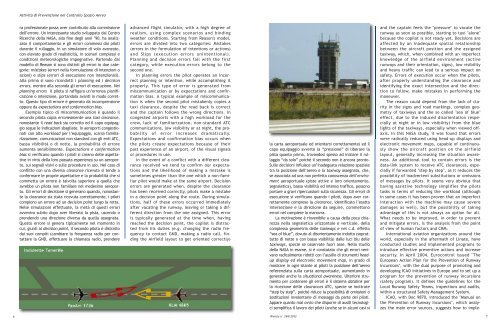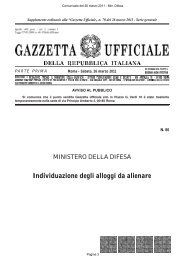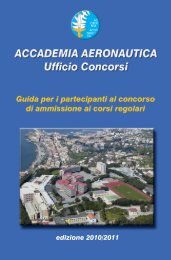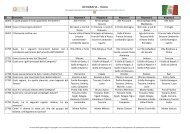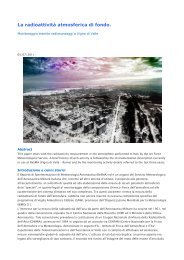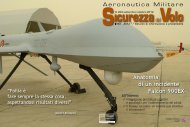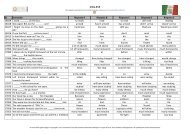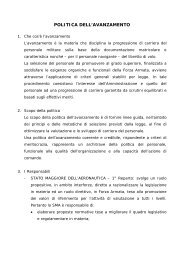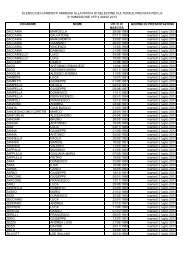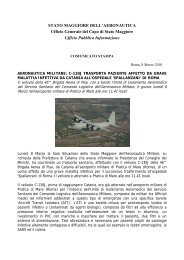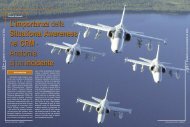Scarica l'intera rivista in formato pdf - Aeronautica Militare Italiana
Scarica l'intera rivista in formato pdf - Aeronautica Militare Italiana
Scarica l'intera rivista in formato pdf - Aeronautica Militare Italiana
You also want an ePaper? Increase the reach of your titles
YUMPU automatically turns print PDFs into web optimized ePapers that Google loves.
Attività di Prevenzione nel Controllo Spazio Aereo<br />
ra professionale possa aver contribuito alla commissione<br />
dell’errore. Un <strong>in</strong>teressante studio sviluppato dal Centro<br />
Ricerche della NASA, alla f<strong>in</strong>e degli anni ’90, ha analizzato<br />
il comportamento e gli errori commessi dai piloti<br />
durante il rullaggio, <strong>in</strong> un simulatore di volo avanzato,<br />
con elevato grado di realisticità, <strong>in</strong> scenari complessi e<br />
condizioni meteorologiche impegnative. Partendo dal<br />
modello di Reason si sono dist<strong>in</strong>ti gli errori <strong>in</strong> due categorie:<br />
mistakes (errori nella formulazione di <strong>in</strong>tenzioni o<br />
azioni) e slips (errori di esecuzione non <strong>in</strong>tenzionali).<br />
Alla prima si sono ricondotti i plann<strong>in</strong>g ed i decision<br />
errors, mentre alla seconda gli errori di esecuzione. Nei<br />
plann<strong>in</strong>g errors il pilota si raffigura un’erronea pianificazione<br />
o <strong>in</strong>tenzione, portandola avanti <strong>in</strong> modo corretto.<br />
Questo tipo di errore è generato da <strong>in</strong>comprensione<br />
oppure da expectations and confermation bias.<br />
Esempio tipico di miscommunication è quando il<br />
secondo pilota copia erroneamente una taxi clearance,<br />
nonostante il read back sia corretto ed il capo equipaggio<br />
segue le <strong>in</strong>dicazioni sbagliate. In aeroporti congestionati<br />
con alto workload per l’equipaggio, scarsa familiarizzazione,<br />
comunicazioni non standard con gli enti ATC,<br />
bassa visibilità o di notte, la probabilità di errore<br />
aumenta sensibilmente. Expectations e confermation<br />
bias si verificano quando i piloti si creano delle aspettative<br />
<strong>in</strong> virtù della loro passata esperienza su un aeroporto,<br />
sui segnali visivi o sulle procedure <strong>in</strong> uso. Nel caso di<br />
conflitto con una diversa clearance ricevuta si tende a<br />
confermare le proprie aspettative e la probabilità che si<br />
commetta un errore è talvolta superiore a quella che<br />
avrebbe un pilota non familiare nel medesimo aeroporto.<br />
Gli errori di decisione si generano quando, nonostante<br />
la clearance sia stata ricevuta correttamente, i piloti<br />
compiono un errore ad un decision po<strong>in</strong>t lungo la rotta.<br />
Nelle simulazioni effettuate, la metà di questi errori<br />
avveniva subito dopo aver liberato la pista, uscendo o<br />
prendendo una direzione diversa da quella assegnata.<br />
Questo errore si genera tipicamente nel momento <strong>in</strong><br />
cui, giunti al decision po<strong>in</strong>t, il secondo pilota è distratto<br />
dai suoi compiti (cambiare la frequenza radio per contattare<br />
la GND, effettuare la chiamata radio, prendere<br />
advanced flight simulator, with a high degree of<br />
realism, us<strong>in</strong>g complex scenarios and b<strong>in</strong>d<strong>in</strong>g<br />
weather conditions. Start<strong>in</strong>g from Reason's model,<br />
errors are divided <strong>in</strong>to two categories: Mistakes<br />
(errors <strong>in</strong> the formulation of <strong>in</strong>tentions or actions)<br />
and Slips (execution errors un<strong>in</strong>tentional).<br />
Plann<strong>in</strong>g and decision errors fall with the first<br />
category, while execution errors belong to the<br />
second one.<br />
In plann<strong>in</strong>g errors the pilot operates an <strong>in</strong>correct<br />
plann<strong>in</strong>g or <strong>in</strong>tention, while accomplish<strong>in</strong>g it<br />
properly. This type of error is generated from<br />
miscommunication or by expectations and confirmation<br />
bias. A typical example of miscommunication<br />
is when the second pilot mistakenly copies a<br />
taxi clearance, despite the read back is correct<br />
and the capta<strong>in</strong> follows the wrong directions. In<br />
congested airports with a high workload for the<br />
crew, lack of familiarization, non-standard ATC<br />
communications, low visibility or at night, the probability<br />
of error <strong>in</strong>creases dramatically.<br />
Expectations and confirmation bias occurs when<br />
the pilots create expectations because of their<br />
past experience of an airport, of the visual signals<br />
or procedures <strong>in</strong> use.<br />
In the event of a conflict with a different clearance<br />
received we tend to confirm our expectations<br />
and the likelihood of mak<strong>in</strong>g a mistake is<br />
sometimes greater than the one which a non-familiar<br />
pilot would make at the same airport. Decision<br />
errors are generated when, despite the clearance<br />
has been received correctly, pilots make a mistake<br />
<strong>in</strong> a decision po<strong>in</strong>t along the route. Dur<strong>in</strong>g simulations,<br />
half of these errors occurred immediately<br />
after vacat<strong>in</strong>g the runway, leav<strong>in</strong>g or tak<strong>in</strong>g a different<br />
direction from the one assigned. This error<br />
is typically generated at the time when, hav<strong>in</strong>g<br />
reached the decision po<strong>in</strong>t, the copilot is distracted<br />
from his duties (e.g. chang<strong>in</strong>g the radio frequency<br />
to contact GND, mak<strong>in</strong>g a radio call, f<strong>in</strong>d<strong>in</strong>g<br />
the Airfield layout to get oriented correctly)<br />
la carta aeroportuale ed orientarsi correttamente) ed il<br />
capo equipaggio avverte la “pressione” di liberare la<br />
pista quanto prima, trovandosi spesso ad <strong>in</strong>iziare il rullaggio<br />
“da solo” poiché il secondo non è ancora pronto.<br />
Sulle decisioni <strong>in</strong>fluisce un’<strong>in</strong>adeguata relazione spaziale<br />
tra la posizione dell’aereo e la taxiway assegnata, che,<br />
se associata ad una non perfetta conoscenza dell’enviroment<br />
aeroportuale (piste attive e loro orientamento,<br />
segnaletica), bassa visibilità ed <strong>in</strong>tenso traffico, possono<br />
portare a gravi ripercussioni sulla sicurezza. Gli errori di<br />
esecuzione si verificano quando i piloti, dopo aver correttamente<br />
compreso la clearance, identificato l’esatta<br />
<strong>in</strong>tersezione e la direzione da seguire, commettono<br />
errori nel compiere la manovra.<br />
La motivazione è r<strong>in</strong>venibile a causa della poca chiarezza<br />
nella segnaletica orizzontale e verticale, della<br />
complessa geometria delle taxiways e nel c.d. effetto<br />
“sea of blue”, dovuto al disorientamento <strong>in</strong>dotto (soprattutto<br />
di notte o con bassa visibilità) dalle luci blu delle<br />
taxiways, specie se osservate fuori asse. Nello studio<br />
della NASA <strong>in</strong> esame, si è constatato che gli errori venivano<br />
radicalmente ridotti con l’ausilio di strumenti headup<br />
display ed electronic movement map, <strong>in</strong> grado di<br />
mostrare <strong>in</strong> ogni istante ai piloti la posizione dell’aereo<br />
referenziata sulla carta aeroportuale, aumentando <strong>in</strong><br />
generale anche la situational awareness. Ulteriore strumento<br />
per contenere gli errori è il sistema datal<strong>in</strong>k per<br />
la ricezione delle clearances ATC, specie se <strong>in</strong>oltrate<br />
“step by step”, poiché riduce la possibilità di omissioni o<br />
sostituzioni <strong>in</strong>volontarie di messaggi da parte dei piloti.<br />
Appare quanto mai ovvio che disporre di ausili tecnologici<br />
semplifica il lavoro dei piloti (anche se <strong>in</strong> alcuni casi si<br />
and the capta<strong>in</strong> feels the "pressure" to vacate the<br />
runway as soon as possible, start<strong>in</strong>g to taxi "alone"<br />
because the copilot is not ready yet. Decisions are<br />
affected by an <strong>in</strong>adequate spatial relationship<br />
between the aircraft position and the assigned<br />
taxiway, which, when comb<strong>in</strong>ed with an imperfect<br />
knowledge of the airfield environment (active<br />
runways and their orientation, signs), low visibility<br />
and heavy traffic can lead to a serious impact on<br />
safety. Errors of execution occur when the pilots,<br />
after properly understand<strong>in</strong>g the clearance and<br />
identify<strong>in</strong>g the exact <strong>in</strong>tersection and the direction<br />
to follow, make mistakes <strong>in</strong> perform<strong>in</strong>g the<br />
maneuver.<br />
The reason could depend from the lack of clarity<br />
<strong>in</strong> the signs and road mark<strong>in</strong>gs, complex geometry<br />
of taxiways and the so called "sea of blue"<br />
effect, due to the <strong>in</strong>duced disorientation (especially<br />
at night or <strong>in</strong> low visibility) from the blue<br />
lights of the taxiways, especially when viewed offaxis.<br />
In this NASA study, it was found that errors<br />
were radically reduced us<strong>in</strong>g head-up displays and<br />
electronic movement maps, capable of cont<strong>in</strong>uously<br />
show the aircraft position on the airfield<br />
layout, generally <strong>in</strong>creas<strong>in</strong>g the situation awareness.<br />
An additional tool to conta<strong>in</strong> errors is the<br />
data-l<strong>in</strong>k system to receive ATC clearances, especially<br />
if forwarded "step by step", as it reduces the<br />
possibility of <strong>in</strong>advertent substitutions or omissions<br />
of messages by pilots. It seems very obvious that<br />
hav<strong>in</strong>g assistive technology simplifies the pilots<br />
tasks <strong>in</strong> terms of reduc<strong>in</strong>g the workload (although<br />
<strong>in</strong> some cases it has been proven that an imperfect<br />
<strong>in</strong>teraction with the mach<strong>in</strong>e may cause severe<br />
damages as well), but the possibility of tak<strong>in</strong>g<br />
advantage of this is not always an option for all.<br />
What needs to be improved, <strong>in</strong> order to prevent<br />
and mitigate errors, is the analysis from the po<strong>in</strong>t<br />
of view of human factors and CRM.<br />
International aviation organizations around the<br />
world, especially <strong>in</strong> the aftermath of L<strong>in</strong>ate, have<br />
conducted studies and implemented programs to<br />
<strong>in</strong>troduce effective preventive actions and <strong>in</strong>crease<br />
security. In April 2004, Eurocontrol issued "The<br />
European Action Plan for the Prevention of Runway<br />
<strong>in</strong>cursions", with the dual purpose of promot<strong>in</strong>g and<br />
develop<strong>in</strong>g ICAO <strong>in</strong>itiatives <strong>in</strong> Europe and to set up a<br />
program for the prevention of runway <strong>in</strong>cursions<br />
(safety program). It def<strong>in</strong>es the guidel<strong>in</strong>es for the<br />
Local Runway Safety Teams, <strong>in</strong>spections and audits,<br />
with<strong>in</strong> a structured Safety Management System.<br />
ICAO, with Doc 9870, <strong>in</strong>troduced the "Manual on<br />
the Prevention of Runway Incursions", which analyzes<br />
the ma<strong>in</strong> error sources, suggests how to imple-<br />
6<br />
Rivista n° 294/2012<br />
7


